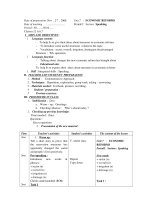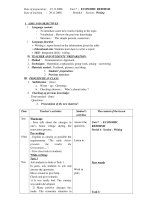lesson plan METHODOLOGY 1
Bạn đang xem bản rút gọn của tài liệu. Xem và tải ngay bản đầy đủ của tài liệu tại đây (129.27 KB, 6 trang )
LESSON PLAN
Instructor: Phan Thị Bích Ngọc
Group: Đặng Thị Cẩm Tú
Nguyễn Thị Thùy Linh
Trần Thị Quỳnh Nhi
Lesson: Language Focus, Comparatives, Unit 16: Historical places.
Class details: A class of 10
th
graders.
Time allotted: 45 minutes
Aims: To help students learn and practice the structure of comparatives.
Objectives: By the end of the lesson, students will be able to:
- Use the comparatives to compare two people or two things.
- Produce language using the structures comparatives accurately.
Teaching aids and Materials: Realia (a piano model and a pig model), textbook, chalk, pictures
Anticipated problems: Some students may be too shy to express their ideas.
Time Stages Activities Work
arrangements
3ms. Warm-up Aims:
- Catch students attention and interest
- Help students recognize the target lesson
Steps:
Step 1: Teacher reads the poem “When I was young”
aloud and students listen.
WHEN I WAS YOUNG
(By a teacher)
When I was young I could run and run,
Though now I am older, I walk.
When I was a child I could be very wild,
But now I am happy to talk.
I'm older and wiser , an English teacher,
I can set you any test.
But in a few years I'll retire, no tears,
And then I'll be able to rest.
Step 2: Ask students to pay attention to the words in the
poem whenever teacher raises a figure in order to guess what
the lesson be about.
T – Whole class
12
ms
Presentation Setting the scene: A month ago was my birthday. I received
a lot of beautiful presents from my family and my friends.
However, I have a special habit, quite different from other
people. That is saving money to buy beautiful things for
myself whenever my birthday comes. That is what I want to
do on my birthday. And this year, I bought 2 things.
- Show the realia (a pig and a piano) and their prices (the pig:
20.000VND, the piano model: 200.000VND)
* Situation 1:
- Teacher elicits the marker sentence: Compare the two
prices, can I say “The pig is as cheap as the piano?”
(expected answer: “No”). So, how can we say?
- Students give their guessed sentence.
- Teacher gives the correct sentence: The pig is cheaper
than the piano.
- Teacher writes the sentence on the blackboard.
- Teacher read the marker sentence and let the students
repeat.
- Teacher points to the word “cheaper” and elicit the
comparative form of short adjectives:
+ What is this? (expected answer: “adjective – er than”)
+ How many syllables are there in this adjective? (expected
answer: “one syllable”)
+ So, do we call it a short adjective or a long adjective?
(expected answer: “a short adjective”)
- Teacher write the comparative form of short adjectives on
the board:
Form:
S1 + be + short adj + er + than + S2
- Teacher elicits the use:
+ T: When you use this structure, how many things are
you comparing? (expected answer: 2 things)
+ T: Do we add “er” to long or short adjectives? (expected
answer: short adjectives)
- Teacher writes the use in the board:
Use: to compare two things with short adjectives (usually
one syllable).
* Situation 2:
- Teacher elicits the marker sentence using the comparative
form of long adjectives:
T: “And now, if I compare the price of the piano with the
price of the pig, can I say “The piano is expensiver than the
pig”? (expected answer: “No”). So, how we I say?
- Students give their guessed sentence.
- Teacher give the correct sentence: The piano is more
expensive than the pig.
- Teacher write the sentence on the blackboard.
- Teacher read the sentence aloud and let students repeat.
- Teacher points to the words “more expensive” and elicit the
comparative form of long adjectives:
T – Whole class
+ What is this? (expected answer: “more –adjective - than”)
+ How many syllables are there in this adjective? (expected
answer: “three syllables”)
+ So, do we call it a short adjective or a long adjective?
(expected answer: “a long adjective”)
- Teacher writes the form of comparative form of long
adjectives on the board:
+ Form:
S1 + be + more + long adj + than + S2
- Teacher elicits the use:
+ Do we add “more” to short or long adjectives?”
(expected answer: long adjectives)
+ How many syllabus are there in a long adjective? One
or more than one? (two or more than two syllables)
- Teacher writes the use on the board:
+ Usage: to compare 2 things with long adjectives (two
syllables or more)
Notes:
1. Adjectives ending with “y” and having a consonant
preceding , change “y” into “i” before adding “er”
Ex: dry → drier
2. Adjectives ending with “e”, just add “r”.
Ex: large → larger
wide → wider
3. Adjectives ending with a consonant and having a
vowel preceding that consonant, duplicate that
consonant before adding “er”.
Ex: big bigger
hot hotter
thin thinner
4. Long adjectives ending with “y”, “le”, “er”, “ow” are
considered as short adjectives.
Ex: happy happier
simple simpler
clever cleverer
narrow narrower
Irregular Adjectives:
Adjectives Comparatives
good
bad
little
many, much
far
better
worse
less
more
farther
further
7ms. Controlled
Practice
Step 1: Teacher show the cue 1 (the word “Rich” ) ,
eliciting:
+ Who’s this? (point to the picture on the left side)
(expected answer: the son)
+ Who’s this? (point to the picture on the right side)
(expected answer: the father)
+ Make the comparison, with “How is…”
(write “How is…” on the board)
Teacher says: How is the father?
(expected answer: The father is richer than the son.)
Step 2: Model and drill the cue 1 based on the picture.
+ Say the utterance “The father is richer than the son”
twice.
+ Get the whole class to repeat chorally twice and correct.
T ask & Ss answer and vice versa:
+ Teacher ask: “How is the father?”
+ The whole class answer: “The father is richer than the
son.”
+ The whole class ask and teacher answer.
Individual practice:
+ Call on 2 students to repeat it individually and correct.
• T: How is the father?
• S: The father is richer than the son.
Step 3: Work on the cue 2: (the word “Intelligent”)
Teacher show the cue 2, eliciting:
+ Who’s this? (point to the picture on the left side)
(expected answer: Dekhi)
+ Who’s this? (point to the picture on the right side)
(expected answer: Nobita)
+ Make the comparison, with “How is…” (point to “How
is…” on the board)
How is Dekhi?
(expected answer: Dekhi is more intelligent than Nobita.)
Model and drill the cue 2 based on the picture.
+ Say the utterance “Dekhi is more intelligent than Nobita.”
twice.
+ Get the whole class to repeat chorally twice and correct.
T ask & Ss answer and vice versa:
+ Teacher ask: “How is Dekhi?”
+ The whole class answer: “Dekhi is more intelligent than
Nobita.”
+ The whole class ask and teacher answer.
Individual practice:
+ Call on 2 students to repeat it individually and correct.
• T: How is Dekhi?
T – Whole class
• S: Dekhi is more intelligent than Nobita.
Step 4: Work through the rest of the cues
Step 4: Open pairs: Get 3 pairs to demonstrate the exchange
in open pairs.
Step 5: Closed pairs:
Teacher divides the class into pairs, the puts 2 cues on the
board. While Ss are doing their pair work, T goes around the
classroom as a monitor, taking notes some common mistakes
for indirect correction.
Pairwork
8ms Further
Practice
T: Now, let’s play a game.
Step 1: T explains the rule.
+ Do you remember this game? (T draws a ca-ro board on the
blackboard.)
+ The English version is called Noughts and Crosses. It looks
like this. (point to the board prepared).
+ How can we win?
(expected answer: 3 in a row)
+ Across? (Yes); Down? (Yes); Like this? (Yes?)
+ Divide the class into 2 teams: Noughts and Crosses
+And now, we have 9 numbers like this. Each team , one by
one, choose a number and make a comparative sentence. If
you are right, you will have one mark. If you are wrong, the
other team will have a chance to answer.
Step 2: T checks the understanding of the students.
+ What do you do first? (Choose a number)
+ Then, what do you have to do? (Make a comparison)
T – Whole class
14ms Production - Ask the students to read three advertisements on the black
board.
- Ask them some questions to check their understanding.
• What are advertised?
(an apartment, a villa and a house)
• How old are they?
• (The apartment is 2 years old, the villa is 5 years old
and the house is new)
• How much do we pay per month?
(900.000 dong for the apartment, 6.6 million dong for the
house and 7.8 million dong for the villa)
- Divide the class into 2 teams and ask them to play the
game lucky number.
- Write 10 numbers from the board, from 1 to 10. Three of
them are lucky numbers.
- Each team takes turn to choose a number and make a
sentence with a word for each number, using comparatives
T – Whole class
1m Homework
related to 3 ads.
- Each correct answer will get 1 point. If students choose a
lucky number, they do not need to make any sentences but
they get 2 points and they can choose another number.
E.g.: T: Cheap
S: The house is cheaper than the villa.
1. Hot
2. Lucky number
3. Expensive
4. Modern
5. Lucky number
6. Beautiful
7. Old
8. Lucky number
9. Small
10. New
***Possible answers:
1. The apartment is hotter than the house.
2. The house is more expensive than the apartment.
3. The house is more modern than the apartment.
4. The Villa is more beautiful than the apartment.
5. The villa is older than the house.
6. The apartment is smaller than the house.
7. The house is newer than the villa.
SS can make more sentences
Ask students to write 10 comparative sentences in their
notebooks.









